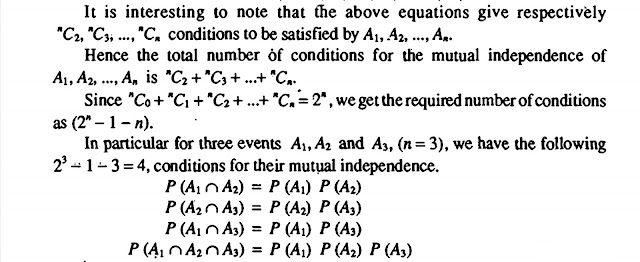[If you are beginner in probability then you should read Probability Theorem (Part-1) before Read the below content]
THEOREM- 4:
For any 3 events A , B , C P( A ⋃ B | C ) = P( A | C ) + P( B | C ) P( A ⋂ B | C )
PROOF:
We have P( A ሀ B ) = P( A ) + P( B ) - P( A ⋂ B )
⇒P[( A ⋂ C) ⋃ ( B ⋂ C )] = P( A ⋂ C ) + P( B ⋂ C ) - P( A ⋂ B ⋂ C )
Dividing both sides by P( C ), we get
⇒ P[( A ⋂ C) ⋃ ( B ⋂ C )] / P( C ) = P( A ⋂ C ) / P( C ) + P( B ⋂ C ) / P( C ) - P( A ⋂ B ⋂ C ) / P( C ) , P( C ) > 0
⇒ P[( A ⋃ B ) ⋂ C ] / P( C ) = P( A | C ) + P( B | C ) - P( A ⋂ B | C )
⇒ P[( A ⋃ B ) | C ] = P( A | C ) + P( B | C ) - P( A ⋂ B | C )
[Proved]
THEOREM - 5:
For any 3 events A , B , C P(A ⋂ B' | C ) + P( A ⋂ B | C ) = P( A | C ) , B' = complementary of event B.
PROOF :
Given,
P(A ⋂ B' | C ) + P( A ⋂ B | C )
= P(A ⋂ B' ⋂ C ) / P( C ) + P( A ⋂ B ⋂ C ) / P( C )
= [ P(A ⋂ B' ⋂ C ) + P( A ⋂ B ⋂ C ) ] / P( C )
= P(A ⋂ C ) / P( C )
= P( A | C ) [Proved]
THEOREM - 6:
For any 3 events A , B , C defined on the sample space S such that B ⊂ C and P( A ) > 0 , P( C | A ) ≥ P( B | A ).
PROOF:
P( C | A ) = P( C ⋂ A ) / P( A ) [ By definition of conditional probability]
= [ P( B ⋂ C ⋂ A ) ⋃ P( B' ⋂ C ⋂ A ) ] / P( A )
= [ P( B ⋂ C ⋂ A ) ] / P( A ) + [ P( B' ⋂ C ⋂ A ) ] / P( A )
= P [ ( B ⋂ C | A ) + ( B' ⋂ C | A ) ]
Since B ⊂ C ⇒ B ⋂ C = B
⇒ P( C | A ) = P( B | A ) + P( B' ⋂ C | A )
⇒ P( C | A ) ≥ P( B | A ). [Proved]
Pair-wise Independent Events:
Definition: A set of events A1 , A2 , ... , An are said to be pair-wise independent if
P( Ai ⋂ Aj ) = P( Ai ) . P( Aj ) ∀ i ≠ j
Conditions for Mutual Independence of ' n ' Events :
Let S denote the sample space for a number of events . The events in S are said to be mutually independent if the probability of the simultaneous occurrence of (any) finite number of them is equal to the product of their separate probabilities.
If A1 , A2 , ... , An are ' n ' events , then their mutual independence , we should have
(i) P( Ai ⋂ Aj ) = P( Ai ) . P( Aj ) , [ i ≠ j ; i , j = 1,2,...,n]
(ii) P( Ai ⋂ Aj ⋂ Ak ) = P( Ai ) . P( Aj ) . P( Ak ) , [ i ≠ j ≠ k ; i , j , k = 1,2,...,n]
. .
. .
. .
P( A1 ⋂ A2 ⋂ ... ⋂ An ) = P( A1 ) . P( A2 ) . ... . P( An )
Remarks :
1. It may be observed that pair-wise or mutual independence of events A1 , A2 , ... , An is defined only when P( A1 ) ≠ 0 , for i = 1,2,...,n .
2. If the events A and B are such that P( A ) ≠ 0 , P( B ) ≠ 0 and A independent of B , then B is independent of A.
Proof : We are given that , P( A | B) = P( A )
[∵ A is independent of B ]
⇒ P( A ⋂ B ) / P( B ) = P( A )
⇒ P( A ⋂ B ) = P( A ) . P( B )
⇒ P( B ⋂ A ) / P( A ) = P( B ) [∵ P( A ) ≠ 0 , A ⋂ B = B ⋂ A ]
⇒ P( B | A ) = P( B )

No comments:
Post a Comment